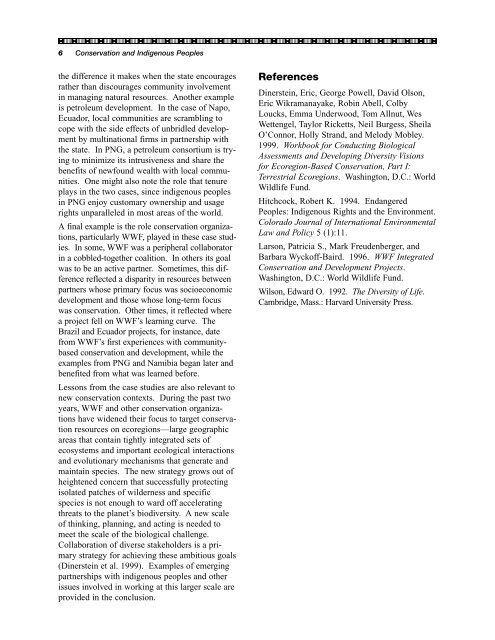Indigenous Peoples and Conservation Organizations
Indigenous Peoples and Conservation Organizations
Indigenous Peoples and Conservation Organizations
Create successful ePaper yourself
Turn your PDF publications into a flip-book with our unique Google optimized e-Paper software.
6 <strong>Conservation</strong> <strong>and</strong> <strong>Indigenous</strong> <strong>Peoples</strong><br />
the difference it makes when the state encourages<br />
rather than discourages community involvement<br />
in managing natural resources. Another example<br />
is petroleum development. In the case of Napo,<br />
Ecuador, local communities are scrambling to<br />
cope with the side effects of unbridled development<br />
by multinational firms in partnership with<br />
the state. In PNG, a petroleum consortium is trying<br />
to minimize its intrusiveness <strong>and</strong> share the<br />
benefits of newfound wealth with local communities.<br />
One might also note the role that tenure<br />
plays in the two cases, since indigenous peoples<br />
in PNG enjoy customary ownership <strong>and</strong> usage<br />
rights unparalleled in most areas of the world.<br />
A final example is the role conservation organizations,<br />
particularly WWF, played in these case studies.<br />
In some, WWF was a peripheral collaborator<br />
in a cobbled-together coalition. In others its goal<br />
was to be an active partner. Sometimes, this difference<br />
reflected a disparity in resources between<br />
partners whose primary focus was socioeconomic<br />
development <strong>and</strong> those whose long-term focus<br />
was conservation. Other times, it reflected where<br />
a project fell on WWF’s learning curve. The<br />
Brazil <strong>and</strong> Ecuador projects, for instance, date<br />
from WWF’s first experiences with communitybased<br />
conservation <strong>and</strong> development, while the<br />
examples from PNG <strong>and</strong> Namibia began later <strong>and</strong><br />
benefited from what was learned before.<br />
Lessons from the case studies are also relevant to<br />
new conservation contexts. During the past two<br />
years, WWF <strong>and</strong> other conservation organizations<br />
have widened their focus to target conservation<br />
resources on ecoregions—large geographic<br />
areas that contain tightly integrated sets of<br />
ecosystems <strong>and</strong> important ecological interactions<br />
<strong>and</strong> evolutionary mechanisms that generate <strong>and</strong><br />
maintain species. The new strategy grows out of<br />
heightened concern that successfully protecting<br />
isolated patches of wilderness <strong>and</strong> specific<br />
species is not enough to ward off accelerating<br />
threats to the planet’s biodiversity. A new scale<br />
of thinking, planning, <strong>and</strong> acting is needed to<br />
meet the scale of the biological challenge.<br />
Collaboration of diverse stakeholders is a primary<br />
strategy for achieving these ambitious goals<br />
(Dinerstein et al. 1999). Examples of emerging<br />
partnerships with indigenous peoples <strong>and</strong> other<br />
issues involved in working at this larger scale are<br />
provided in the conclusion.<br />
References<br />
Dinerstein, Eric, George Powell, David Olson,<br />
Eric Wikramanayake, Robin Abell, Colby<br />
Loucks, Emma Underwood, Tom Allnut, Wes<br />
Wettengel, Taylor Ricketts, Neil Burgess, Sheila<br />
O’Connor, Holly Str<strong>and</strong>, <strong>and</strong> Melody Mobley.<br />
1999. Workbook for Conducting Biological<br />
Assessments <strong>and</strong> Developing Diversity Visions<br />
for Ecoregion-Based <strong>Conservation</strong>, Part I:<br />
Terrestrial Ecoregions. Washington, D.C.: World<br />
Wildlife Fund.<br />
Hitchcock, Robert K. 1994. Endangered<br />
<strong>Peoples</strong>: <strong>Indigenous</strong> Rights <strong>and</strong> the Environment.<br />
Colorado Journal of International Environmental<br />
Law <strong>and</strong> Policy 5 (1):11.<br />
Larson, Patricia S., Mark Freudenberger, <strong>and</strong><br />
Barbara Wyckoff-Baird. 1996. WWF Integrated<br />
<strong>Conservation</strong> <strong>and</strong> Development Projects.<br />
Washington, D.C.: World Wildlife Fund.<br />
Wilson, Edward O. 1992. The Diversity of Life.<br />
Cambridge, Mass.: Harvard University Press.

















